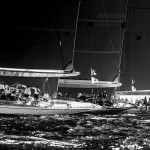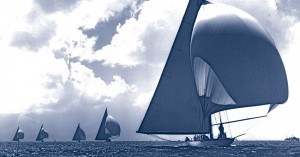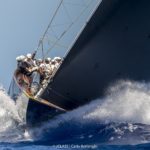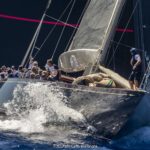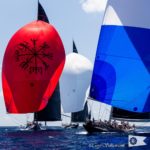Before the J Class yachts came into existence, yachts were designed to be bigger and bigger. The towering rigs of the Big Boat Class such as ‘Lulworth’ and ‘Britannia’ dwarfed all other yachts. The late 1920s heralded discussion and agreement of the Universal Rule. This new formula controlled the size and displacement of the new yachts, enabling them to be raced as evenly as possible. Almost immediately, designs were being commissioned for the new, massive ‘Bermudan rigs, with no bowsprits’.
The rule was based on ideas proposed by Nat Herreshoff allowing waterline length to be increased without sail area being restricted, as it had been under the International Rule. This was compensated by a larger displacement and so draught was limited to 15ft.
1929
In 1929 Sir Thomas Lipton, owner of Lipton’s famous for his import of Lipton Tea from India, issued his fifth challenge to the Americans for the America’s Cup. He commissioned the build of the first J Class Yacht which signified the start of a new era in design evolution and racing. On each occasion he challenged for the America’s Cup as a member of the Royal Ulster Yacht Club in Northern Ireland. RUYC are still involved with The Cup – presenting the Royal Ulster Cup to the Club of the winning challenger.
1930
The Universal Rule came into effect in 1930. The size of a yacht was determined (by waterline length) and this was shown as an alphabetical list. “J” signified yachts with a waterline length of between 75 to 87 feet. The addition of the new design Bermuda mast allowed the yachts to carry a huge sail plan. Nothing so large and ‘awesome’ had been built previously. The Americans had a distinct advantage over Britain in the 1930 America’s Cup. They had the money to build four J’s over Britain’s one, yet the British yacht, Shamrock V was a hot contender. She was designed by Nicholson and built at the family yard in 1930, and before she crossed the Atlantic to attend the Cup she had notched up more than 700 sea miles (1,296km), won 15 out of the 22 races she had entered and had been tweaked and tested to a high degree.
In answer to Lipton’s challenge of 1929 the Americans designed four J-Class yachts as possible defenders. Enterprise, Whirlwind, Yankee and Weetamoe were launched within a month of each other; Weetamoe and Enterprise from the Herreshoff yard and Yankee and Whirlwind from Lawley & Son’s yard in Bristol.
Whirlwind, the second J, was the most revolutionary of the four. Francis L Herreshoff had moved away from conventional yachts and designed a boat, which took the new rule to its extreme. Whirlwind combined many new ideas and Herreshoff experimented with hull shape and rig. She was the longest of the early J’s at 86ft on the waterline and remained so until Ranger and Endeavour II were built in 1937.
She was built of semi-composite construction (the other three American Js were built out of the highly expensive Tobin bronze), was double-ended and had a permanent backstay. Uffa Fox described her profile as: “Very pleasing to the eye, the stem sweeping down to the keel in a very sweet line, and to a man who, like myself, believes that a pointed stern is a logical ending for all vessels, her stern is a joy to behold.” He predicted, “If the Yacht Racing Rules govern well and wisely, we shall see Whirlwind racing 50 years hence. If they do not she will probably be cruising then.” But Whirlwind met an early demise. Her building was delayed as she didn’t meet Lloyd’s A1 scantling rules and she wasn’t chosen to be the 1930s defender. She was often out-performed when close hauled, her steering gear making her difficult to steer. She was eventually scrapped along with Enterprise in 1935. However, her unusual double-headsail rig was later adopted by the rest of the Js.
The third American J, Yankee, was the best all-rounder. At 84ft on the waterline and 125ft length overall, she was solidly made of Tobin bronze and was extremely well balanced. Designed by Frank Paine, Yankee had an almost straight sheerline and easy lines. She was a powerful contender for defender, but not fine-tuned enough to succeed. She did, however, take part in the 1934 America’s Cup trials and with alterations to her rig, to carry more sail, and bow, which was lengthened and made more of a V-shape, she then proved more successful, especially in light winds.
The fourth of the American J’s was Weetamoe, which was designed by Clinton Crane and was the narrowest of the early four. Despite claims that Yankee was the best all-rounder, Weetamoe is said to have been the closest rival to Enterprise to be the Cup defender. Charles Nedwick, in Ian Dear’s book Enterprise to Endeavour, describes Weetamoe as having a profile “that is practically a triangle, with a straight line from the after end of the waterline to the bottom of the keel and thence a line which is slightly convex, and then slightly concave to the forward end of the waterline.” In an attempt to better performance and make her less tender, her profile below the water was radically altered in 1934 with a new contour and bulb keel. The alterations failed and not long afterwards were reversed. In common with the other J’s, she had about 43ft of overhang and her hull, Nicholson opined, “was the best of all the US Js”.
When Shamrock V and Enterprise eventually met off Newport, Rhode Island, later that year, the two J’s were well matched in hull profile, but differed significantly in rig. Enterprise’s rigging was lighter, she had the Park Avenue boom, which was so advantageous to windward, and had lots of winches on board. Shamrock V meanwhile, was under-winched and hard work to sail. She has since, however, proved her success in that she is still sailing today.
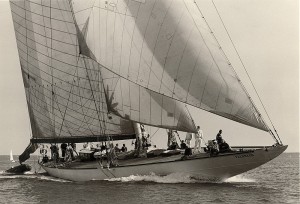
1933
The sixth J-Class yacht to be built, and the second built on British soil was Velsheda. She was the only J not built as a contender for the America’s Cup. Her owner, WL Stephenson, who previously owned White Heather II, the 23-Metre converted to rate as a J-Class in 1930, had Velsheda built in steel in 1933 at the Camper & Nicholson yard. Velsheda was a great success. In 1935 she was significantly altered, her bow was snubbed around the waterline and her stern improved. The following season she won the King’s Cup at Cowes Week.
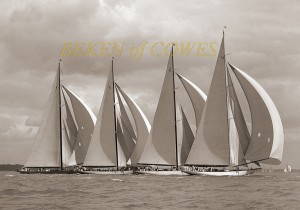
1934
In 1934, Sopwith challenged for the America’s Cup. His challenger was Endeavour. She was Charles Nicholson’s third J-Class design and he said of her “She will have quite a normal hull… because I have thought it right to suppress possible experimental form, which would be most interesting to try out, but which I have to leave to American designers.” He did, however, produce the most beautiful J-Class and her rig was innovative.
Sopwith experimented with new running backstay strain gauges, which controlled the trim of the mast and used electronic windspeed and direction indicators. It has since been suggested that part of the reason for her failure in the Cup was due to all the gadgets on board. She was matched 83ft 3in on the waterline against Rainbow’s 82ft. However, despite being thought to be the best challenger Britain has ever built, she did not win the Cup. Rainbow, which was considered the inferior boat, beat her by four races to two.
In answer to Lipton’s challenge of 1929 the Americans designed four J-Class yachts as possible defenders. Enterprise, Whirlwind, Yankee and Weetamoe were launched within a month of each other; Weetamoe and Enterprise from the Herreshoff yard and Yankee and Whirlwind from Lawley & Son’s yard in Bristol.

Rainbow was designed by W Starling Burgess and launched in 1934 from the Herreshoff yard where she was built in just 100 days. The J stepped a pear-shaped duralumin mast, designed to take the strain of the double-headed jib – first used on Whirlwind – and she was originally rigged with a Park Avenue boom. This was later removed because it was considered too heavy.
1935
The UK Class was depressed with the death of King George V and scuttling of his yacht “Britannia” off the South of the Isle of Wight, in accordance with his will.
Of the American Js, Yankee was the only one to sail in British waters when she was bought by Gerald Lambert and crossed the Atlantic in 1935. She was scrapped in 1941. Enterprise and Whirlwind were both scrapped in America.
1937
1937 saw the building of the last two J’s on both sides of the Atlantic. Both Ranger and Endeavour II took the waterline length to its extreme, measuring 87ft LWL. Ranger, the American boat, was built at Bath Ironworks in Maine and designed jointly by W Starling Burgess and Olin Stephens. It was a design combination, which produced the greatest J of the fleet – the ‘super J’ as she was later known. She was built, for the cost of the materials only, of flush riveted steel plating and soon after launching had an accident. The upper parts of her rod rigging which stayed her duralumin mast shook loose and her mast snapped “with a report like a cannon”.
Ranger’s success on the water was widespread. Of 37 starts she won 35. Owner-skipper Harold Vanderbilt described her as being “slower to turn and to pick up speed, but (she) held her way longer, and was perfectly balanced on the wind.” The challenger, Endeavour II, was designed by Nicholson again and built at the C&N yard. She too was steel, but flush-plated above and below the waterline. Sopwith towed her and Endeavour, plus an entourage of 100, to America where he worked on tuning her rig. Sadly, Ranger saw off the competition, easily winning four races, and dashing British hopes.
Although they became recognised the most beautiful yacht design in the world, only 10 J Class yachts were ever built – 6 in the USA and 4 in the UK. Most of these competed in trials for the America’s Cup, or competed in the Cup itself. Several existing large British yachts, ‘Astra’, ‘Candida’, ‘White Heather II’ and ‘Britannia’, the King’s yacht, were all converted to comply with the rule and raced alongside the J’s.
After the victory of Ranger over Endeavour II, Vanderbilt wondered whether the boat was so much faster than the competition that it might kill the class. History would show this was not the case as analysis of the Holm design shows that it would likely have been faster than Ranger.
1937 marked the end of an era – it was the last America’s Cup contest for 21 years and marked the end of Big Yacht racing. Shamrock V was sold to Mario Crespi, the Italian Senator and publisher, who converted her to a ketch rig and renamed her ‘Quadrifoglio’, with a literal translation giving her authentic name of ‘4 leaves’ in Italian. This was in accordance with an Italian law, which forbade foreign names.
Weetamoe was scrapped in this year, while at the end of the season Ranger was laid up, prior to being scrapped in 1941.
HANDLING THE J CLASS YACHTS IN THE 1930’s
The Skippers had to be experienced in racing and their skill on the race circuit became a matter of pride. These mighty craft had no engines and they had to be handled with great precision to get into and out of ports. Often their experience came from sailing all types of small craft, including fishing boats, during the winter months, when the J Class yachts were laid up. The permanent racing crew in the early days was probably around 16 men thou this may have been augmented to around 30 for racing. When not required for sail changes, spare crew were often moved to below decks.
With the incredible loads on the rigging and systems it was a constant concern that J Class masts could collapse in winds above a Force 3.
Sailing small boats in often inhospitable waters gave them the skills to manage their J Class yachts. The same is true today. Skippers have to deliver their yachts across Oceans, and compete around the race course, using their skills and all the technical advantages that are available today.
1938
It is now clear that there was another J Class Yacht under development in 1937. Several years ago, drawings for a J-Class boat by Swedish naval architect Tore Holm were discovered by Fred Meyer, (Société Nautique de Genève – the Defender of the 32nd America’s Cup).
Now known as the Holm Project, this was to be a Swedish yacht with an innovative design. Many of the hull plates were made – and exist to this day. The project was put on hold prior to the outbreak of War in 1939 and was forgotten for more than 60 years. Endeavour and Endeavour II (K6) were laid up at Camper & Nicholson’s yard in Gosport, England.
1940
Rainbow was scrapped. By the end of 1941, all the US yachts, which had been laid up were scrapped for their metal, with the last two being Yankee and Ranger. None survived. Yankee’s owner Gerard Lambert allegedly donated her scrap money from the yacht to Queen Mary to be used at her discretion in the London Hospital, in memory of the courtesies shown to Yankee by King George and the Queen herself.
1947
Endeavour II was sold for scrap to Charles Kerridge Limited but her hulk remained until the late 1960s. Endeavour and Velsheda became houseboats in a mud berth on the River Hamble. This is where they stayed for more than 30 years, protected by the mud, which they had sunk into. Only Shamrock V was still sailing.
1968
Endeavour II was broken up and scrapped in Southampton. Quadrifoglio (Shamrock V) had been hidden in Italy in a barn throughout the war years and following Crespi’s death in 1962 was sold to Piero Scanu, who saved her just two weeks before she was due to be broken up in Genoa.
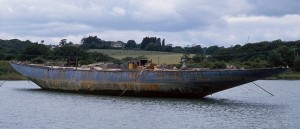
1974
During the 1970s Endeavour’s hulk was sold for £10 and restoration was started.
1975
Quadrifoglio (Shamrock V) arrived from Italy and was refitted at Camper & Nicholson’s yard where she had been built, supervised by Paolo Scanu the naval architect, and son of the owner.
1979
The large holes in Endeavour’s hull were plugged and she was towed to the old seaplane base at Calshot Spit on the Solent to start restoration.
1984
Terry Brabant rescued Velsheda from her Hamble mud berth and gave her enough of a refit to get her chartering and, occasionally, racing again in events like the annual Round the Island Race, hosted by the Island Sailing Club in Cowes. Despite being in rather poor condition she still acquitted herself well and looked magnificent from a distance. Swiss plans to restore her came to nought and the old racing yacht was eventually laid up afloat in Gosport. Elizabeth Meyer took on the challenge to continue with the rebuild of Endeavour at Calshot.
1986
Quadrifoglio (Shamrock V) was purchased in 1986 by the Thomas Lipton Company, and given back her original name of Shamrock V, when she became the property of the Newport Museum of Yachting. Endeavour was towed from Calshot, to Cowes on the Isle of Wight to have her fittings and rigging fitted. She was then taken on a barge to the Royal Huisman Shipyard in Holland to continue and complete the rebuild.
1989
Endeavour was relaunched in Holland. Endeavour and Shamrock V match raced each other over the Old America’s Cup course in Newport, Rhode Island in August.
1997
Velsheda was purchased from a bankrupt C&N boatyard and brought to Southampton Yacht Services to start her rebuild. She was relaunched in 1998 and started her programme of racing and cruising around the World.
1998
Velsheda, Shamrock V and Endeavour raced against each other in Antigua Classic Week.
2000
The Owners met in England and formed the J Class Association to protect the interests of the Class, present and future. Class Rules were established for the construction of Replica Rebuilds from original plans. Shamrock V came out of a major refit at Pendennis in Falmouth under the supervision of the Dykstra office.

2001
The first J Class Regatta is held in Christchurch Bay on England’s south coast over three days, followed by the Jubilee Regatta in Cowes.
2002
Ranger replica was commissioned and construction started at Danish Yacht Shipyard.
2003
Ranger was launched and started her racing programme.
2007
Replicas of Endeavour II (Hanuman) and Ranger (Lionheart) are commissioned.
2008
Replicas of Rainbow and Paine design (JH7) are commissioned.
2009
Hanuman, replica of Endeavor II launched.
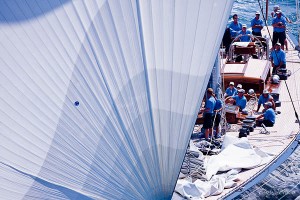
2010
Lionheart launched.
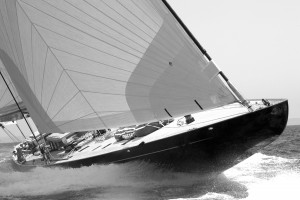
2012
Rainbow launched. Cheveyo commissioned from Sparkman & Stephens / Spirit Yachts.

Information courtesy of the J Class Association
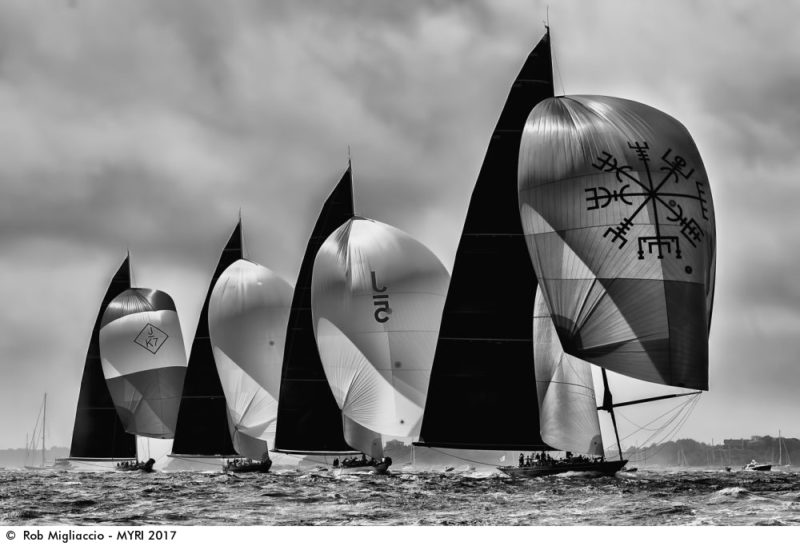
Svea, Velsheda and Topaz at the St Barths Bucket, 2018.
More here.

